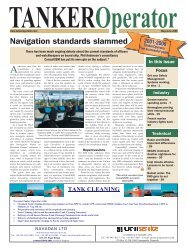Features: - Tanker Operator
Features: - Tanker Operator
Features: - Tanker Operator
You also want an ePaper? Increase the reach of your titles
YUMPU automatically turns print PDFs into web optimized ePapers that Google loves.
INDUSTRY - FOCUS ON GERMANY<br />
Predetermined breaking point. In a collision, the malleable inner hull of the tanker will bulge inwards without causing an oil spill.<br />
(Graphics – Lindenau)<br />
On any ship you will find the cage's<br />
equivalent. It is formed by longitudinal<br />
stringers and vertical frames. Stringers and<br />
frames make up the skeleton that supports the<br />
outer and inner hulls of the ship and which are<br />
spaced about 2 m apart. The critical question<br />
is how to enable the inner shell to separate<br />
from this supporting cage, thereby enlarging<br />
this space.<br />
As far as the longitudinal stringers are<br />
concerned, the solution is straightforward<br />
enough- the stringers are welded only to the<br />
outer hull and have no contract with the inner<br />
hull. A more complicated matter is the case of<br />
the vertical frames. A series of holes, known<br />
as perforated pre-determined breaking points,<br />
are made in the sections closest to the inner<br />
shell. In a collision, the frames are intended to<br />
rupture at these locations, thus releasing the<br />
inner shell. The larger number of breaking<br />
frames, the better.<br />
This design concept was first developed by<br />
Lindenau partner and former managing<br />
director Guenter Stehn, who estimated that<br />
frames may break over a length of 20 m along<br />
a ship's body, allowing the austenitic inner<br />
shell to bulge inwards by several metres<br />
without rupturing. To ensure that this works,<br />
tanks may not be fully loaded and must be<br />
fitted with burst plates designed to break on<br />
impact. The cargo then flows into a<br />
neighbouring tank or ballast tank.<br />
What made Stehn's approach appealing was<br />
its simplicity. The vessel's inner shell deforms<br />
without causing an oil spill. But how far can<br />
this be taken before the ship's structure<br />
becomes unstable? As it is, sailing in rough<br />
seas is a punishing experience for a tanker,<br />
exposing it to incessant assaults from different<br />
load combinations, a constant interplay of<br />
compressive and tensile stresses.<br />
This relentless strain is particularly<br />
aggressive around cut outs and holes where<br />
cracks may form. Perforated pre-determined<br />
breaking points are not exempt from this<br />
threat. The critical question is, how should the<br />
perforations be designed so the frames only<br />
fail in a collision as intended while<br />
safeguarding the structural integrity of the<br />
vessel during normal operations?<br />
In his dissertation completed under the<br />
supervision of TUHH's Professor Eike<br />
Lehmann, Tautz analysed the hidden pitfalls<br />
of calculation methods that simulate the<br />
planned failure of pre-determined breaking<br />
points. The ductile yield of austenitic steel,<br />
while known, does not help in determining the<br />
highly important parameter of time of failure<br />
when calculating collision simulations.<br />
Knowing the time of failure is critical. If a<br />
tank shell separation from the frames is too<br />
late, the striking vessel might penetrate it.<br />
No matter how many calculations are<br />
performed, there is no substitute for physical<br />
measurements and practical tests. To<br />
accommodate this, Lindenau has requested<br />
research funding from the German Federal<br />
Ministry of Economic Affairs. The research<br />
project aims at clarifying important aspects of<br />
operational and collision safety.<br />
Operational safety measurements have<br />
already begun on a ship section built<br />
according to the new design concept and<br />
installed on the 44,700 dwt product tanker<br />
Seychelles Patriot.<br />
Seychelles Patriot. One side<br />
section was built with integrated<br />
predetermined breaking points.<br />
(Photo – Lindenau)<br />
August/September 2008 � TANKER<strong>Operator</strong> 25

















